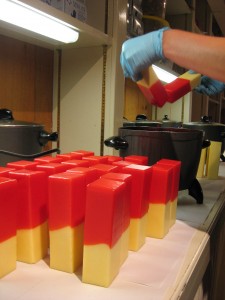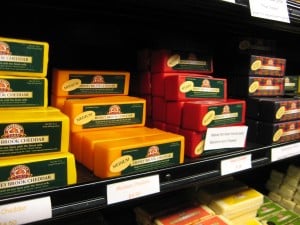Say you’ve just walked up to the dairy case at Weaver’s Orchard and picked up an 8 ounce block of aged Honey Brook Cheddar from September Farm, one of Weaver’s vendors. You’ve noticed the cheese’s ingredients– milk, cheese culture, rennet, and salt–and these make the product in your hand seem so simple. But if you’ve had this cheese before, you know that something nearly magical has transformed these ingredients to make this mouth-puckering cheddar so good.
Part of the magic is that this 8 ounce block of glorious sharpness has been developing for years before you pick it up. This particular cheddar has aged for three years in a climate-controlled room.
So, let’s go back three years to this Honey Brook Cheddar’s birth. Watch September Farm’s eight-minute video of the cheese being made, and it looks easy, but the process itself takes five hours.
First, three thousand pounds of pasteurized milk pumps into a stainless steel vat. As steel stirring arms spin slowly, David Rotelle, who owns and operates September Farm with his wife, Roberta, and their family, sprinkles a cheese culture over the milk. This culture identifies the kind of cheese this will be and the kind of aging process it will need.
Soon, David adds rennet, a natural enzyme, and the mixture looks as thick as the custard in crème brûlée– it is now beginning to look more like cheese than milk.
After this, David and Roberta break up the mixture with curd knives, which look like a cross between a giant spatula and a small pasture gate. Soon, curds and whey will form as steam begins to cook the curds. Whey (90% of the mixture) drains off, and salt (the only preservative used) gets sprinkled on top.
Next, David, Roberta, and a few helpers mix the curds and press them into steel molds lined with cheesecloth.

Once out of the molds, the cheese is packaged in large blocks and aged. After aging, the cheese gets sliced with a delicate wire and weighed. Cheese that weighs under 8 ounces is gathered up to be used for cheese balls and cup cheese. The blocks that do weigh 8 ounces get dipped in wax.
What seemed simple is really a long, fragile process that requires the cheese-maker to be alert, strong, and careful. Crafting humble ingredients into glorious cheese is no easy task.
But let’s go back even further, before the three-years of aging and the five hours of cheese-making. Great cheese–the kind that wins national awards like the Rotelle’s cheese does– depends on high-quality milk, and the Rotelles know exactly where this milk comes from.
The 3,000 pounds of milk they use on cheese-making days comes from 50 cows they own and care for themselves. They oversee the crucial task of keeping cows healthy, and this ensures that these healthy cows produce the best milk possible. Raising them naturally is important, too; none of September Farm’s cows receive hormones. The Rotelle family milks the cows twice a day and lets them outside for frequent exercise. Three times a day, they feed the cows alfalfa and corn.
Examining what the cows are eating sends us back even further in time. The alfalfa and corn silage were grown at September Farm. This lets the Rotelles ensure one more layer of quality control.
But even all of these steps aren’t enough to create a good product. Making cheese, says Roberta Rotelle, takes “life-long mastery.” You can’t just say you’re going to make great cheese and expect it to happen, she says. Making cheese requires education– about milk and its properties, for instance, and about the complex aging process. Roberta and David have both pursued the education that the art and science of cheese-making requires. They are both licensed in cheese making from the University of Wisconsin, and Roberta earned a degree in food service management from the University of New Hampshire.
When you think about it, years of labor for the cheese that graces the shelves of Weaver’s Orchard’s dairy case and September Farm’s own lush country store makes sense. Simplifying anything takes work. Simplifying a room means a daily battle against clutter, simplifying one’s lifestyle takes years of self-discipline, and making a meal with fewer ingredients means that meal, if it’s going to be good, will take time. “It is simplicity,” writes priest and chef Robert Farrar Capon, “that takes the most doing.”
And for David and Roberta Rotelle, the steady and delicate work with simple ingredients resulted from carefully planning and rearranging of their lives so they could raise their family on a farm. David “did everything else in his life so he can do this,” says Roberta.
Slowly, the dream of a simple life on a farm solidified into this Honey Brook, PA cheese making business. When the Rotelles explored the history and the current farms and businesses in Lancaster County, they realized, says Roberta, that “Lancaster County has lost the art of cheese making.” Though there are still a few wholesale cheese makers in the county and a few small cheese makers, the Rotelles envisioned a farm store laid out so that customers could watch simple ingredients transforming into cheese and could sample the delicious results.
September Farm is the result of years of planning for a business that allows the family to be together, to linger over conversation with their customers, and to deliver what they confidently believe is “the best product we can possibly offer.”

